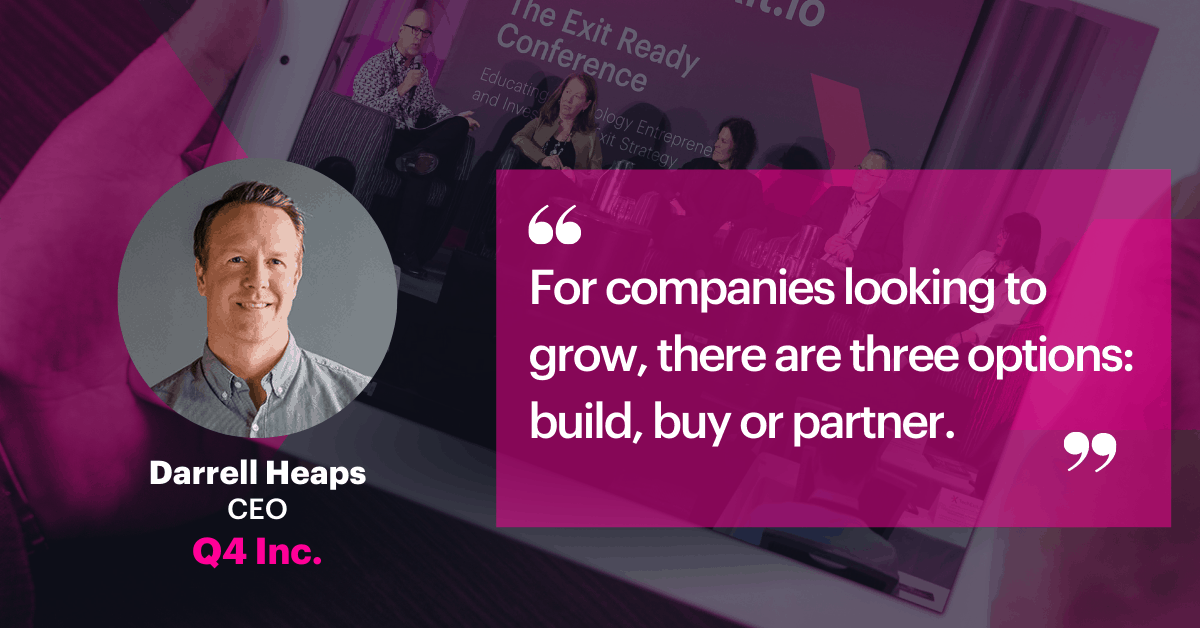How to Be A Buyer and Use an Acquisition Strategy to Drive Growth
TechExit

Darrell Heaps knows what it takes to get a deal done. As a serial entrepreneur, he has spent his career building software companies, from small to large. He founded his first company — a web development and design agency — in the mid-90’s and sold it in 1999, staying on to run it. After the dotcom bubble burst, the company didn’t have enough capital to survive and eventually shut down.
“The problem with my first company is that it was a professional services model. There is no recurring revenue, you ‘eat what you kill’, and you build no enterprise value. When tough times hit, it is nearly impossible to keep the business going,” says Darrell.
Today he is the CEO of Q4 Inc., a leading provider of cloud-based investor relations and capital markets solutions, with over 2,300 customers globally. The company’s purpose is to help their clients win in the capital markets and drive premium valuation through its connected platform, data and analytics.
Over the years, Darrell has seen the advantage of using acquisitions as a growth strategy.
“As your business grows, you build strength and increase your leverage as a result of the size of your business and the value of your equity. You can use these — along with an acquisition strategy — to accelerate your growth plan and expand your business in a significant way, ” says Darrell.
Since 2015, acquisitions have played a significant role in Q4’s growth. “We’ve gone through a couple of funding rounds and have been able to raise a good amount of capital. As part of our growth strategy, we identified other businesses in our space that we felt would help us accelerate either our product roadmap, or market consolidation. Whether we acquired some technology, a great team, or customers, in each case we were able to acquire it and grow the company much faster than if we only focused on organic growth.”
For companies looking to grow, there are three options: build, buy or partner. Founders and leaders need to be clear on their vision for the business and decide if they will build their business to be acquired or if they will use acquisitions to drive growth.
Any acquisition is a lot of work in terms of getting the deal done and then integrating the newly acquired clients and employees into the buyer’s company. Even if a deal seems relatively small, it can require significant resources to complete.
Darrell stresses the importance of a measured approach. “A company should never go to the market in a non-strategic way, with the mindset of ‘let’s see what we can buy’. Doing so can get you into a lot of trouble. Even the smallest deal takes a ton of effort and is distracting. If the deal is not strategic, it can pull you in the wrong direction and suck a ton of resources. In the worst cases, the wrong deal can destroy your company. So, it has to be strategic and don’t underestimate what it will take to make it a success.”
If you are considering an acquisition, be very clear on the problem you are trying to solve. Is there a gap in your products that this acquisition will fill? Are you acquiring customers in a market rather than trying to build organically? It’s important to understand the options you have to achieve your objectives and compare build, buy and partner strategies off one another.
When preparing to sell, what steps should companies take to attract the right buyer? A deep understanding of their industry and market is essential. From an internal perspective, this means really digging into your own company’s key metrics and understanding what it means so you can share it with a prospective buyer with confidence. The more you understand your business and customers, the more clearly you will be able to help the buyer understand how your business will fit with their operations.
While there is a big focus on exits, Darrell argues that there is a lot of opportunity for certain companies and entrepreneurs to remain focused on their company and how large of a business they can really build.
“I’ve seen many companies exit early, ones that I felt could have become much larger businesses.” says Darrell “However, many entrepreneurs focus on providing an exit for themselves and their shareholders as soon as possible, particularly in Canada. In today’s market though, it’s possible to keep raising money while providing an exit to shareholders through secondary financing. This allows the company to continue to grow, while providing liquidity to those who want it.”
Join Darrell and his panel for the TechExit East session, “How to be a Buyer: When it Makes Sense to Ante Up.” Register for TechExit.io today.
BACK






